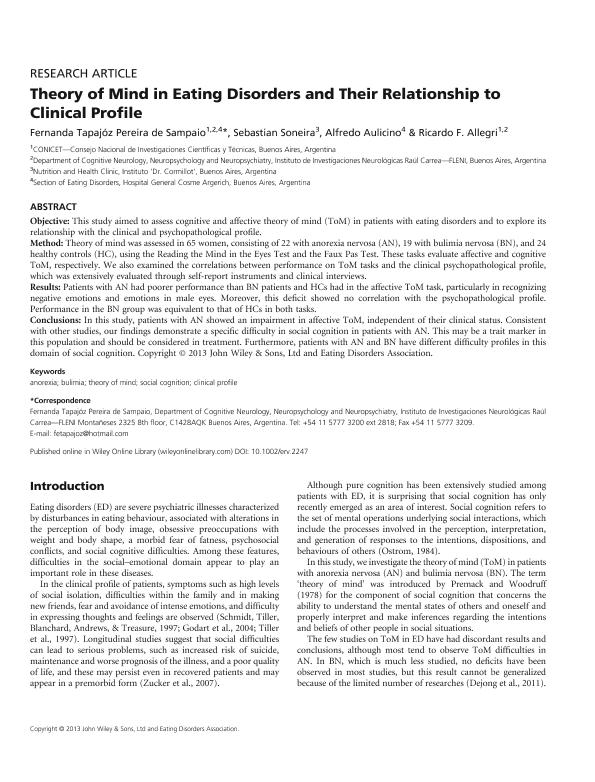Mostrar el registro sencillo del ítem
dc.contributor.author
Tapajoz Pereira de Sampaio, Fernanda

dc.contributor.author
Soneira, Sebastian
dc.contributor.author
Aulicino, Alfredo
dc.contributor.author
Allegri, Ricardo Francisco

dc.date.available
2019-10-17T21:38:48Z
dc.date.issued
2013-11
dc.identifier.citation
Tapajoz Pereira de Sampaio, Fernanda; Soneira, Sebastian; Aulicino, Alfredo; Allegri, Ricardo Francisco; Theory of mind in eating disorders and their relationship to clinical profile; Wiley; European Eating Disorders Review; 21; 6; 11-2013; 479-487
dc.identifier.issn
1072-4133
dc.identifier.uri
http://hdl.handle.net/11336/86255
dc.description.abstract
Objective This study aimed to assess cognitive and affective theory of mind (ToM) in patients with eating disorders and to explore its relationship with the clinical and psychopathological profile. Method Theory of mind was assessed in 65 women, consisting of 22 with anorexia nervosa (AN), 19 with bulimia nervosa (BN), and 24 healthy controls (HC), using the Reading the Mind in the Eyes Test and the Faux Pas Test. These tasks evaluate affective and cognitive ToM, respectively. We also examined the correlations between performance on ToM tasks and the clinical psychopathological profile, which was extensively evaluated through self-report instruments and clinical interviews. Results Patients with AN had poorer performance than BN patients and HCs had in the affective ToM task, particularly in recognizing negative emotions and emotions in male eyes. Moreover, this deficit showed no correlation with the psychopathological profile. Performance in the BN group was equivalent to that of HCs in both tasks. Conclusions In this study, patients with AN showed an impairment in affective ToM, independent of their clinical status. Consistent with other studies, our findings demonstrate a specific difficulty in social cognition in patients with AN. This may be a trait marker in this population and should be considered in treatment. Furthermore, patients with AN and BN have different difficulty profiles in this domain of social cognition.
dc.format
application/pdf
dc.language.iso
eng
dc.publisher
Wiley

dc.rights
info:eu-repo/semantics/openAccess
dc.rights.uri
https://creativecommons.org/licenses/by-nc-sa/2.5/ar/
dc.subject
ANOREXIA
dc.subject
BULIMIA
dc.subject
CLINICAL PROFILE
dc.subject
SOCIAL COGNITION
dc.subject
THEORY OF MIND
dc.subject.classification
Neurología Clínica

dc.subject.classification
Medicina Clínica

dc.subject.classification
CIENCIAS MÉDICAS Y DE LA SALUD

dc.title
Theory of mind in eating disorders and their relationship to clinical profile
dc.type
info:eu-repo/semantics/article
dc.type
info:ar-repo/semantics/artículo
dc.type
info:eu-repo/semantics/publishedVersion
dc.date.updated
2019-10-17T13:43:10Z
dc.identifier.eissn
1099-0968
dc.journal.volume
21
dc.journal.number
6
dc.journal.pagination
479-487
dc.journal.pais
Reino Unido

dc.journal.ciudad
Londres
dc.description.fil
Fil: Tapajoz Pereira de Sampaio, Fernanda. Consejo Nacional de Investigaciones Científicas y Técnicas; Argentina. Ministerio de Defensa. Ejército Argentino. Hospital Militar Central Cirujano Mayor "Dr. Cosme Argerich"; Argentina. Fundación para la Lucha contra las Enfermedades Neurológicas de la Infancia; Argentina
dc.description.fil
Fil: Soneira, Sebastian. Instituto Dr. Cormillot; Argentina
dc.description.fil
Fil: Aulicino, Alfredo. Ministerio de Defensa. Ejército Argentino. Hospital Militar Central Cirujano Mayor "Dr. Cosme Argerich"; Argentina
dc.description.fil
Fil: Allegri, Ricardo Francisco. Consejo Nacional de Investigaciones Científicas y Técnicas; Argentina. Fundación para la Lucha Contra las Enfermedades Neurológicas de la Infancia. Instituto de Investigaciones Neurológicas "Raúl Carrea"; Argentina
dc.journal.title
European Eating Disorders Review
dc.relation.alternativeid
info:eu-repo/semantics/altIdentifier/url/http://onlinelibrary.wiley.com/doi/10.1002/erv.2247/
dc.relation.alternativeid
info:eu-repo/semantics/altIdentifier/doi/https://doi.org/10.1002/erv.2247
Archivos asociados
